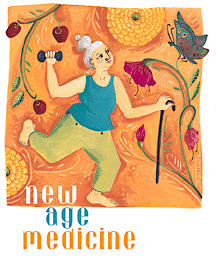

Throughout the years, the center has developed and tested inexpensive, practical ways for older adults to improve their health, well-being and physical function. And it has done so in a somewhat unconventional way--going out into the community, including senior centers and low-income housing, to reach seniors in need of support.
Lois Shaw found help last year. Shortly after suffering a stroke, the 83-year-old started exercise classes in her subsidized housing unit.
"I've come a long, long way," Lois bubbles, her voice a mix of pride and glee. "I went from using a walker to a cane, and I don't even need the cane when I'm at home."
The regular exercises have also helped Lois continue her own cooking and housework. And she receives regular comments from friends and neighbors about her progress.
"It's really got me on my feet again," she professes.
Success stories like Lois' make preventive medicine appear quite simple. And while the messages may indeed be basic ones--exercise more, feel better--instilling them into people's daily lives requires a combination of many crucial elements. These include: developing successful programs, working with community partners, motivating individuals to cultivate their health, enhancing individual support networks and creating projects with staying power.

Should seniors lift weights? Back in 1993, neither center researchers nor residents at the Northshore Senior Center knew the answer to this question. And so began one of the center's first studies, the Wellness Intervention Study for Elders, which tested and implemented a method to prevent disability from falls.
Six months later, after participating in one-hour fitness sessions three times a week, the group of 50 seniors reported some pleasant surprises. From increased balance and movement--being able to bend over and tie shoes, walk up stairs and work in the garden--to general health improvements--decreases in blood pressure, lessening of heart palpitations, increased energy and stamina.
In further analysis, researchers found participants had overall improvements in walking distance and knee strength, significant decreases in depressive symptoms and a 25 percent reduction in restricted activity days.
"This study helped us see the possibilities of what a basic, structured program could do at the community level," Buchner explains. "Providing inexpensive ways to promote lifestyle change and tapping the resources of an existing infrastructure are the elements needed for real success."
Findings of the center's initial studies helped provide the foundation for the many projects to follow. Rather than going it alone, researchers teamed with community partners to extend the reach and success of their efforts.
Ruth Herr didn't know where to turn after being diagnosed with osteoporosis three years ago. Active all her life--ice skating since she was 8, walking three miles daily--the 80-year-old woman wasn't ready to slow down, but she knew she would need help to keep her body moving.
"I was desperate to find something or someone that could help me fight this," she relates.
After more than a year of searching, Herr found what she was looking for at a local senior center--one of the exercise studies offered through the UW program. She enrolled and two years later still participates in exercise classes each week.
"This program has been a lifesaver for me," she says. "I feel better, I've made some great friendships and I've had wonderful support from people who care."
Partners in Prevention
Staying Active: 11 Tips for the Elderly
Send a letter to the editor at columns@u.washington.edu.